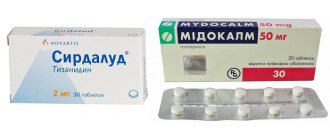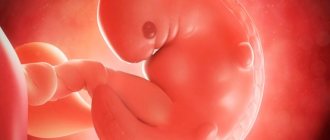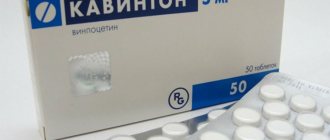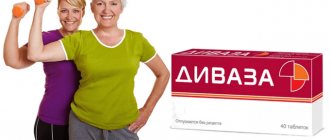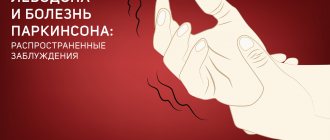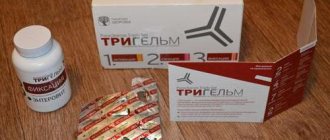Almost every fifth baby is exposed to intrauterine pathologies. This is often due to underdevelopment of the nervous system, so after birth doctors are forced to improve the functioning of the child’s brain in order to properly adapt to the external environment. For such purposes, Cortexin is used for infants and newborns.
Release form
The drug is available in the form of a sterile lyophilized powder for the preparation of a solution for intramuscular administration.
The cardboard packaging is completed with two blister packs, each containing 5 bottles of lyophilisate, and instructions for use.
In pharmacies you can buy Cortexin 10 mg No. 10 and Cortexin 5 mg No. 10.
Cortexin 10 mg is available in 22 mg doses in 5 ml bottles. The product is intended for the treatment of adult patients.
Cortexin 5 mg was created specifically for use in pediatrics. It is available in 11 g bottles with a capacity of 3 ml.
Characteristics of the medicine
Cortexin is a peptide bioregulator. The active substances quickly penetrate the cerebral cortex, overcoming the barrier between the circulatory system and the central nervous system. The main task of nootropic medications is to stimulate the functioning of nerve cells. Cortexin is one of these medications aimed at improving metabolic processes in brain tissue. The active component of the medicine is similar to the name of the product. An additional element is glycine, an amino acid.
You can purchase the drug in dosages of 10 mg and 5 mg. Both options can be prescribed to the baby, the dose is adjusted individually.
Composition and mechanism of action of the drug
The dosage form is a lyophilisate from which a solution for intramuscular administration is prepared: a powder or porous mass of pure white or yellowish tint.
- The active ingredient of the drug is cortexin - a complex of water-soluble polypeptide fractions with a molecular weight of no more than 10,000 Da: in 1 bottle - 5 or 10 mg.
- An auxiliary component (used as a stabilizer) is glycine.
Clinical and pharmacological group: nootropic drug.
The main active ingredient of the drug is cortexin, which is obtained from the cerebral cortex of cattle. It contains proteins that are able to penetrate the porous barrier between blood vessels and tissues of the nervous system and directly affect the child’s brain.
Main effects of the drug:
- normalization and improvement of brain function, especially the cortex;
- improvement of cognitive properties (memory, attention, thinking, speech skills, etc.). Due to this effect, the drug is used for speech delay in a child;
- increasing resistance to stress;
- protection of nerve cells from the toxic effects of various substances;
- reducing the toxic effects on brain cells of certain medications, including psychotropic ones;
- inactivation of the process of fat peroxidation in neurons - antioxidant effect;
- ensuring the survival of neurons during oxygen starvation;
- activation of metabolism in brain tissues and cells;
- stimulation of nerve tissue restoration;
- toning the neuromuscular system.
The main directions of the mechanism of action are as follows:
- activation of neuronal proteins;
- increased activity of factors that provide nutrition and development of neurons;
- normalization of the balance of amino acids that have stimulating and inhibitory effects;
- improvement of bioelectric activity of the brain;
- preventing the synthesis of free radicals.
The manufacturer does not provide information on the excretion and metabolism of the drug due to the peculiarities of the structure of the Cortexin protein molecule.
Cortexin is classified as a nootropic drug. This pharmacological group combines medications that directly affect the tissues of the nervous system and affect higher mental functions. With its regular use, children improve their ability to acquire knowledge, concentration and memory.
Neurologist Victor Koss approves of the use of nootropics in the treatment of neurological diseases: If translated literally, it turns out to be “brain nutrition.” As a rule, it is assumed that the cells of the cerebral cortex can absorb the necessary amino acids, vitamins and microelements to maintain vital functions. The effectiveness of using nootropics has been proven by practice in neurology; today, preparations of amino acids and peptides are very popular.
Side effects and contraindications to use of the product
Cortexin is usually well tolerated. Side effects from the use of the drug rarely occur, however, allergic reactions are sometimes observed, for example, in the form of skin manifestations. Most often, this undesirable effect occurs when novocaine is used as a solvent.
The drug should not be used if there is an individual intolerance to its components, during pregnancy and lactation.
There are no analogues of Cortexin with the same composition, but there are drugs on the market with similar effects that have different release forms (Encephabol, Cerebrolysin, Pantogam).
Most reviews about Cortexin are positive. After using the drug, children experience improvement in cognitive functions, acceleration of mental and motor development and other positive effects. Negative reviews about this product are due to the lack of any positive result from its use or adverse events that arose during the course (for example, allergic reactions).
After Cortexin injections, many children begin to talk, their vocabulary increases and speech clarity improves. Children who were previously diagnosed with “delayed motor development” quickly master the missing skills. Based on the reviews, we can conclude that “talkers” have a beneficial effect on children’s sleep and help children become calmer.
Why are Cortexin injections prescribed, what does the drug help with?
Cortoxil - how to take and for what pathology:
- insufficient cerebral circulation;
- cerebral paralysis;
- traumatic brain injuries;
- cognitive impairment of any kind (memory impairment, thinking and attention disorders);
- encephalopathy;
- epilepsy;
- vegetative-vascular dystonia;
- disruptions in the psychomotor development of children;
- asthenia;
- a sharp decrease in learning ability and information perception;
- delay in children's conversational development;
- damage to the central nervous system in children. The drug Cortexin has wide indications for use, due to which it can be used in the fight against most brain pathologies and disorders of the nervous system.
- previously suffered closed or open traumatic brain injury, as well as its complications and negative consequences;
- disruption of the stable process of cerebral circulation associated with diseases of the great vessels, cerebral ischemia, hereditary predisposition;
- viral or bacterial meningitis, encephalitis, myelitis (in this case, Cortexin should be used as part of complex therapy aimed not only at restoring the functions of the central nervous system, but also at suppressing the activity of pathogenic microorganisms);
- all types of mnestic and intellectual disorders;
- acquired or congenital epilepsy (the drug is not able to completely cure this disease, but its active substances make it possible to achieve stable remission and a significant reduction in the frequency of attacks);
- severe neuroinfections of bacterial or viral origin that affect the peripheral and central nervous system;
- chronic fatigue syndrome, accompanied by changeable mood, manifestations of apathy, depression, indifference to processes occurring in the environment (in this case, the drug becomes effective for teenage children);
- cerebral palsy and complications associated with its presence (Cortexin is used as a primary or auxiliary agent to improve neural conduction of nerve endings, stimulate the centers of the cerebral cortex, increase the functional activity of the musculoskeletal system);
- all types of birth injuries, the consequence of which is the critical condition of the newborn child;
- delayed speech or psychomotor development of children, which does not have a pathological nature of origin;
- congenital hydrocephalus of the brain (the medication supports the functions of the organ, but does not allow for complete restoration of its tissues);
- perinatal damage to cells of the nervous system received at the time of birth;
- decreased cognitive function of the brain, memory problems that are not associated with the presence of concomitant diseases.
Cortexin can be used as a complex agent during the treatment of other neurological disorders. The medication is used to restore stable functioning of the central nervous system in children who have experienced prolonged psycho-emotional stress, a severe stressful situation, or a state of depression.
How it affects the body
Cortexin, as a nootropic, has a positive effect on the central nervous system and mental activity. Symptoms of anxiety disappear. Teenagers learn with desire. Attentiveness increases and information is remembered well. The patient gets rid of headaches and migraines. The drug stops tachycardia, which occurs as a result of stressful situations. The nervous system calms down and heart function stabilizes. The patients showed normalization of blood pressure.
As a neuroprotector, Cortexin increases the stability of brain tissue and neutralizes neurotoxic factors. With oxygen starvation, neurosurvival increases; Cortexin is able to influence oxidation reactions. Free radical processes are suppressed. Cell membranes stop breaking down. Triglycerides and cholesterol are normalized in the blood. The walls of blood vessels become stronger. Blood circulates better.
The transspecific action of Cortexin corresponds to improved metabolism of the PNS and CNS, stimulated reparative processes in the central nervous system. The cerebral cortex in the cerebral hemispheres, as well as the somatic and autonomic systems, is generally restored and its function is normalized.
Side effects
Like other polypeptide neuroleptics, Cortexin causes virtually no side effects.
If novocaine was used as a solvent, its side effects may be as follows:
- Allergic reactions: urticaria, itching, skin rash up to anaphylactic shock.
- Nervous system: dizziness, drowsiness, fatigue, headache.
- Cardiovascular system: pressure surges (decrease and increase), chest pain, arrhythmia.
If you use saline solution or distilled water for injections, then, as a rule, adverse reactions are expressed in redness of the injection site and a burning sensation.
Contraindications
The drug is contraindicated in patients with hypersensitivity to cortexin and/or glycine.
Clinical studies to establish the effect of the drug on the body of a pregnant woman and the developing fetus have not been conducted. For this reason, the drug is not recommended for use at any stage of pregnancy.
Since there are no data from clinical studies regarding the use of the drug during breastfeeding, if it is necessary to prescribe Cortexin, it is recommended to stop breastfeeding.
Opinion of Komarovsky and other doctors
What does Dr. Komarovsky think about Cortexin? A pediatrician with many years of experience does not share the opinion that nootropic therapy is absolutely necessary.
Komarovsky points out that Cortexin does not have clinically proven effectiveness; It is generally not advisable to prescribe it to newborns and children under one year of age. The specialist pays special attention to medications for the treatment of speech disorders in patients under 3 years of age. The doctor explains that you need to treat not with nootropics, but to talk to your baby correctly and regularly.
Vast experience in using the drug, the absence of side effects and positive treatment results do not add up to the benefits of nootropic drugs. Until now, their effectiveness has not been proven through clinical studies.
Other experts claim that amino acids have a positive effect on brain cells. And when the correct dose of medication is prescribed, side effects and other problems do not arise.
There is evidence of incompatibility between Cortexin and drugs with a similar peptide structure. There are no data on the interaction of Cortexin and other drugs.
CORTEXIN lyophilisate - instructions for use
Before the injection, the powder should be diluted with 1-2 ml of 0.5% novocaine solution, 0.9% isotonic sodium chloride solution or water for injection. To prevent foam from appearing, the needle must be directed towards the wall of the bottle.
Cortexin is approved for use in children from the first days of life. For patients weighing no more than 20 kg, the dosage of the drug is 0.5 mg per 1 kg of body weight. If the child’s weight is over 20 kg, then Cortexin is prescribed at a dosage of 10 mg. The duration of treatment is 10 days.
The drug is used in the complex treatment of traumatic brain injuries, cerebral circulatory disorders, neuroinfections, encephalopathies, encephalitis, encephalomyelitis, epilepsy, vegetative-vascular dystonia, cerebral palsy, delayed psychomotor and speech development in children, as well as disorders of memory, thinking and ability to training
Adults receive Cortexin injections once a day, regularly for 10 days at a dosage of 10 mg. For patients with massive ischemic stroke, the dose is increased by 2 times and the drug is administered in the morning and evening for 10 days. Then you will need a 10-day break and repeat the course.
Encephabol or Cortexin, which is better for children?
Encephabol is a nootropic. The medication is available in suspension and tablets. In liquid dosage form, it can be used from birth for memory problems, fatigue, traumatic brain injury, and mental development disorders in children. The drug should not be taken if its composition is intolerant, in patients with chronic rheumatoid arthritis, if they have problems with the kidneys or liver, autoimmune pathologies, changes in blood composition.
Due to treatment, the blood picture may change, nausea, vomiting, liver and kidney dysfunction, diarrhea, inflammation of the oral mucosa, fever, chills, allergies, lack of appetite, joint, headache and muscle pain, sleep disturbances and sensitivity, perversion of taste, myasthenia gravis, dizziness, shortness of breath, hair loss, nail detachment, red dermatitis.
Cortexin: application
Cortexin is a drug that contains polypeptides and neurotransmitters that have a tissue-specific effect on the cerebral cortex. The drug has nootropic (improves brain function, memory, increases resistance to stress, concentrates attention, facilitates learning), antioxidant (promotes the survival of neurons under stress and hypoxia), tissue-specific (improves the functions of the brain and central nervous system) and neuroprotective (reduces toxic effect of taking psychotropic drugs) action. Cortexin is prescribed for traumatic brain injuries, neuroinfections, epilepsy as part of complex therapy, asthenic syndrome, cerebrovascular accidents, encephalopathy, cerebral palsy, memory impairment, and delayed speech and psychomotor development.
Mechanism of action
The active substance of the drug normalizes the level of amino acids that regulate the processes of inhibition and excitation in the cerebral cortex.
In addition, it maintains the balance of neurotransmitters such as dopamine and serotonin.
At the same time, it reduces seizure-like brain activity and prevents the appearance of free radicals.
Thanks to the nootropic effect, memory processes are normalized, concentration improves, and the patient copes with stressful situations more easily. During treatment, an increase in the resistance of brain tissue to various pathogenic factors is observed.
Due to its antioxidant effect, the drug increases the survival rate of neurons during hypoxia.
The tissue-specific effect is manifested by an improvement in the exchange of neurons in the central and peripheral nervous system, activation of restorative processes in the central nervous system, improvement of its activity and increased tone of the nervous system.
After treatment, memory improves, headaches go away, children become calmer, interest in the school curriculum increases, infants experience progress in development, they acquire new skills in a short time (for example, they begin to roll over on their own).
In children suffering from cerebral palsy, after injections, not only speech but motor function improves. In elderly patients, memory improvement is also observed after the end of therapy, and a slowdown in the progression of senile dementia is observed.
Since, upon entering the body, the amino acids and neuropeptides that make up Cortexin disintegrate within 3 minutes, it is not possible to determine the pharmacokinetics of the drug.
Therefore, it is unknown whether the drug penetrates the placenta, whether it is metabolized in the liver, how quickly and how it is excreted from the body, and after what time the maximum concentration in the blood is observed.
Cortexin injections
The drug is available in the form of lyophilisite for the preparation of a solution that must be administered intramuscularly. The lyophilisate can be diluted in 1-2 ml of physiological solution 0.9%, in water for injection or a solution of procaine or novocaine 0.5%. Adults are given injections once a day, 10 mg for 10 days. If necessary, the course of treatment is repeated after 3-6 months. For ischemic stroke in the acute phase, this dosage is administered twice a day for 10 days and after 10 days the course of therapy is repeated. The medicine must be administered slowly, otherwise it may cause severe pain.
Cortexin for children
Cortexin is prescribed to children from birth for perinatal lesions of the nervous system, and for older children with mental and speech retardation, epilepsy and frequent headaches. Children under 5 years of age are prescribed the pediatric form of the drug Cortexin at a dose of 5 mg, half that for adults. The drug is natural, acts gently and slowly, so to achieve the desired effect you need to carry out 3-6 courses of therapy. For children, as well as for adults, the drug is administered intramuscularly, once a day, preferably in the morning, given its activating effect and the ability to provoke psychomotor agitation. Children weighing less than 20 kg are given a dose of 0.5 mg per kilogram of body weight, and children weighing more than 20 kg are given 10 mg per day. Repeated courses are carried out no earlier than after 3-6 months.
Indications for the use of injections
Cortexin for children, the instructions for use of which provide a wide range of indications, is used from any age. It is even used in newborns, since some of them suffer from the consequences of perinatal encephalopathy. The drug has a good effect on the development of the child, and also helps to normalize his behavior (eliminate hysterics, increased nervous excitability).
In everyday life, Cortexin injections are called “talkers,” since after them the child usually begins to speak well (if he previously had a delay in speech development) and quickly and efficiently master new material. If there is a delay in motor development, the use of this remedy most often gives positive results: the baby quickly catches up with his peers in terms of physical skills.
Cortexin is prescribed to schoolchildren to improve cognitive functions, especially if during the educational process difficulties arise with mastering the material, there is poor learning ability, and a poor vocabulary. The drug is recommended for children of any age group in order to eliminate the consequences of the negative effects of various factors on the brain (oxygen starvation, injuries, stressful situations).
How to dilute Cortexin
Many patients who are prescribed to inject this lyophilisate intramuscularly are interested in the question of how to dilute cortexin? Cortexin's instructions contain the same rules for use and dilution of the drug for adults and children. A bottle with one dose of medication is diluted with the following solvents: novocaine, sterile water for injection or a special physiological solution.
All solvents can be purchased for a small price at the pharmacy, since they are not included in the package with the drug. It is better to buy solutions bottled in small containers of 5 ml or 2 ml (ampoules or bottles). This requirement is due to the fact that the liquid for diluting the lyophilisate must be sterile. According to the instructions, dilution should be carried out as follows:
- take a sterile syringe with a needle;
- open the ampoule with the solution;
- lower the needle into the bottle and draw the required amount of solvent (1 – 2 ml);
- remove the foil from the stopper on the medicinal product;
- pierce the stopper with the needle of a syringe that already contains a solvent;
- lower the needle to the middle of the ampoule with lyophilisate;
- press slowly on the syringe plunger;
- release the solvent into the medicine;
- It is necessary, without removing the needle, to gently shake the bottle to completely dissolve the powder;
- a homogeneous solution can be used for injection.
Drug overdose
You already know that the medicine is available in powder form. The lyophilisate is placed in transparent glass ampoules. There is a metal ring on top that protects the inlet. For convenience, it has a special folding zone. Open it.
Before diluting Cortexin, be sure to wash your hands. The palms must be sterile to avoid infection. Open the syringe and fill it with the selected solvent. You will learn about them further from the article. After this, insert the needle into the rubberized cap and gradually pour in the liquid. Make sure that no foam forms.
During the entire period of use of the drug, not a single case of overdose was recorded.
How to dilute Cortexin
The drug itself is available in powder form. For intramuscular injections, you should use a special solution. How to dilute Cortexin? The use of lidocaine is not recommended. Only the following liquids can be used:
- 0.5% procaine;
- 0.5% novocaine;
- injection water;
- 0.9% physiological or sodium chloride solution.
Novocaine is an anesthetic, so it reduces the pain of the injection, although it increases the risk of developing allergies. It is better to use water for injection or solution. One bottle of medicine requires 1 or 0.5 ml of liquid. This solution should be taken to treat an adult. For a child, 2 ml of solvent should be used. Although only a doctor can determine the exact proportion.
Analogues of Cortexin
Level 4 ATX code matches:
Analogues of Cortexin in tablets: Armadin and Armadin Long g, Boluses Huato , Borizol , Glycised , Mexidol , Mexiprim , Glutamic acid , Rilutek , Cytoflavin .
Analogues of Cortexin in ampoules: Armadin , Mexiprim , Neurotropin , Nikomex , Nucleo CMF Forte , Cytoflavin .
Cortexin or Cerebrolysiin - which is better?
Studies conducted on laboratory rats have shown that Cerebrolysin and Cortexin, when administered intraperitoneally and administered into the lateral ventricle of the brain, have a similar effect.
A comparative analysis of the central effects of the drugs led to the conclusion that, despite all their similarities, Cortexin is more active.
At the same time, it provokes a much smaller number of adverse reactions and can be used from birth (whereas Cerebrolysin is used in pediatric practice if there are justified indications).
According to some patients, Cerebrolysin are less painful compared to Cortexin injections.
Intramuscular administration
The medicine must be administered intramuscularly. The injections should be given once every day. Dosage for adults – 10 mg. It is better to use 10 mg ampoules. For a child weighing more than 20 kg, the dosage corresponds to an adult. For babies weighing less than 20 kg, the dosage is selected at the rate of 0.5 mg per 1 kg of weight. It is better for children to use 5 mg ampoules.
Course therapy with Cortexin is 10 days. Therapy can be continued with a second course after a break of 3-6 months. In post-stroke patients, the medicine is prescribed 10 mg twice a day. The course of treatment lasts 10 days. Therapy is repeated after 10 days.
It is better to administer the drug in the morning, as it can cause stimulation of the central nervous system. When the medicine is administered in the evening, the patient's sleep may be disturbed. If a dose of the drug was missed, then a double dosage is administered. The subsequent injection is carried out as prescribed. Intravenous administration of the drug is not permissible.
Analogues by indication and method of use
| Name | Price in Russia | Price in Ukraine |
| Vinpotropil, Vinpocetine, Piracetam | 116 RUR | 260 UAH |
| Calcium hopantenate hopantenic acid | 202 rub. | 216 UAH |
| Memosam piracetam, cinnarizine | — | 17 UAH |
| Nooclerin | 329 RUR | — |
| Pantogam hopantenic acid | 300 rub | 258 UAH |
| Pantocalcin hopantenic acid | 355 rub. | 262 UAH |
| Picamilon nicotinoyl gamma aminobutyric acid | 77 RUR | 63 UAH |
| Phenotropil phenylpiracetam | 415 RUR | 234 UAH |
| Cerebrocurin Cerebrocurin | — | 978 UAH |
| Cogitum dipotassium salt acetylaminosuccinate | 2852 RUR | 100 UAH |
| Noopept noopept | 271 RUR | 320 UAH |
| Vasavital is a combination of many active ingredients | 1240 rub. | 36 UAH |
| Gamalate B6 is a combination of many active ingredients | 1680 rub. | 167 UAH |
| Cognum hopantenic acid | — | 39 UAH |
| Fescetam piracetam, cinnarizine | 211 RUR | — |
| Cinatropil-Health piracetam, cinnarizine | — | 41 UAH |
| Aminalon-KV | — | 4 UAH |
| Gopantham | 189 RUR | — |
| Glycine-Vis glycine | 83 RUR | — |
| Glycine-Bio glycine | 25 rub. | — |
| Cellex polypeptides from fetal pig brain | 6520 rub. | 5000 UAH |
| Glycine-Canon glycine | 4400 rub. | — |
| Glycine-MCPP glycine | 25 rub. | — |
| Cognifen phenibut, ipidacrine | — | 450 UAH |
| Tricortin Combination of phospholipids and cyanocobalamin | 2300 rub. | — |
| Encephabol pyritinol | 540 rub. | 75 UAH |
| Cephabol | — | — |
| Lucetam piracetam | 52 rub. | 13 UAH |
| Memotropil piracetam | — | 164 UAH |
| Nootropil piracetam | 184 RUR | 16 UAH |
| Piratropil Piracetam | — | — |
| Piracetam piracetam | 24 rub. | 2 UAH |
| Piracetam-Richter | — | — |
| Biotropil piracetam | — | — |
| Piracetam-Darnitsa piracetam | — | 10 UAH |
| Piracetam-Health piracetam | — | 14 UAH |
| Metsetam | — | — |
| Cerebril Piracetam | — | — |
| Somazina citicoline | 2790 RUR | 83 UAH |
| Ceraxon citicoline | 494 RUR | 17 UAH |
| Cytokone citicoline | — | 119 UAH |
| Dendrix citicoline | — | — |
| Diphosphocine citicoline | — | 84 UAH |
| Quanyl citicoline | — | 100 UAH |
| Kemodine citicoline | — | — |
| Lyra citicoline | — | 50 UAH |
| Neuroxon citicoline | — | 24 UAH |
| Neocebron citicoline | — | 275 UAH |
| Somaxone citicoline | — | 233 UAH |
| Farmakson citicoline | — | 149 UAH |
| Citicoline-Novo Citicoline | — | 161 UAH |
| Citamax-Darnitsa citicoline | — | — |
| Recognan citicoline | 338 RUR | 1050 UAH |
| Naypilept citicoline | 299 RUR | 621 UAH |
| Encetron citicoline | — | — |
| Novaxone citicoline | — | 156 UAH |
| Citicoline-Astrapharm citicoline | — | 322 UAH |
| Citimax-Darnitsa citicoline | — | 38 UAH |
| Carnitine acetylcarnitine | 426 RUR | — |
| Pram citalopram | — | 453 UAH |
| Pramistar pramiracetam | 2590 RUR | 37 UAH |
| Vinpocetine Vinpocetine | 23 rub. | 3 UAH |
| Vinpocetine Forte | 76 RUR | — |
| Vinpocetine-Acree | — | — |
| Cavinton Vinpocetine | 76 RUR | 22 UAH |
| Cavinton forte vinpocetine | 120 rub. | 89 UAH |
| Vinpocetine-Astrapharm Vinpocetine | — | 14 UAH |
| Vinpocetine-Darnitsa Vinpocetine | — | 17 UAH |
| Vinpocetine-KV Vinpocetine | — | — |
| Vinpocetine-Farmak Vinpocetine | — | — |
| Vicebrol Forte Vinpocetine | — | 106 UAH |
| Neurovin Vinpocetine | — | — |
| Oxopotine Vinpocetine | — | — |
| Vinpocetine-LH | — | 9 UAH |
| Vicebrol | — | 45 UAH |
| Winner-LF Vinpocetine | — | — |
| Vinpocetine-Sar Vinpocetine | 44 rub. | — |
| Adaptol | 505 RUR | 92 UAH |
| Mebicar | 200 rub | 54 UAH |
| Tranquilar | — | 36 UAH |
| Mebicar IC mebicar | — | 54 UAH |
| Tranquilar IC mebicar | — | 36 UAH |
| Noobut IC Phenibut | — | 53 UAH |
| Cerebrolysin Cerebrolysin | 795 RUR | 40 UAH |
| Bifren Phenibut | — | 63 UAH |
| Quattrex Phenibut | — | 59 UAH |
| Noofen phenibut | 700 rub | 20 UAH |
| Noobut IC for children phenibut | — | — |
| Aminalon | 89 RUR | 3 UAH |
| Phenibut phenibut | 26 rub. | 87 UAH |
| Evrizam | — | 8 UAH |
| Neuro-norm piracetam, cinnarizine | — | 10 UAH |
| Olatropil gamma-aminobutyric acid, piracetam | — | 33 UAH |
| Omarone piracetam, cinnarizine | 93 RUR | 15 UAH |
| Thiocetam piracetam, thiotriazoline | 375 RUR | 15 UAH |
| Thiocetam forte piracetam, thiotriazoline | — | 25 UAH |
| Phezam piracetam, cinnarizine | 214 RUR | 13 UAH |
| Noozam piracetam, cinnarizine | — | 15 UAH |
Terms of sale, price of the drug
Purchasing Cortexin in pharmacies is possible only if you have a prescription for such a medication obtained from a pediatrician, neurologist or other specialist. The average price of 10 ampoules, each containing 10 mg of the active compound, is 1,200 rubles. Separately, you should purchase a package with 1-2 ml ampoules of saline solution or water for injection.
It is recommended to keep the box with bottles at home at a temperature below +25 degrees in a place where the product will be hidden from sunlight and inaccessible to children. The shelf life of sealed bottles with powder is 3 years from the date of manufacture. The diluted medicine can be stored for no longer than 20 minutes. If, for any reason, more time has passed after mixing with the solvent, the syringe with the drug must be thrown away, and then diluted and the lyophilisate drawn from a new bottle.
The official manufacturer of Cortexin is pharmaceutical, Russia.
The only form of release of the medicine is a white or light yellow powder obtained by lyophilization (freezing the raw materials and then placing them in a vacuum). The drug is sealed in bottles, which are opened immediately before preparing the solution.
There are 10 vials in a standard cardboard box. The product can be packaged as 5 mg in a 3 ml container or 10 mg (5 ml). The package contains 2 plastic plates, separated by partitions into 5 individual cells each.
The package contains 10 bottles of powder.
The shelf life of the medicine is 2 years. Store it in a dry, dark place at a temperature of 2-20°C. After opening the bottle, prepare the solution and inject within 30 minutes.
The average cost of a package of 10 vials of 5 mg is 760 rubles, of 10 mg is 1291 rubles.
Cortexin price, where to buy
The average price of Cortexin in ampoules of 5 ml of 10 mg each in Russia is 1100-1200 rubles, the average cost of ampoules of 5 mg is 700-850 rubles.
The price of Cortexin 10 mg in Ukraine is 598-685 UAH, the price of Cortexin injections for children varies from 440 to 520 UAH. In Dnepropetrovsk, Zaporozhye and other large cities, you can buy the drug both in a network of retail pharmacies and through online pharmacies with delivery directly to your home.
The drug is not available in tablets.
- Online pharmacies in RussiaRussia
- Online pharmacies in UkraineUkraine
- Online pharmacies in KazakhstanKazakhstan
ZdravCity
- Cortexin lyof. for injection solution for intramuscular injection. 5mg/11mg 10 pcs. Geropharm LLC
- Cortexin lyof. for injection solution for intramuscular injection. 10mg/22mg 10 pcs. Geropharm LLC
Pharmacy Dialogue
- Cortexin (vial 5 mg No. 10) Geropharm
- Cortexin (vial 10 mg No. 10) Geropharm
Europharm* 4% discount using promo code medside11
- Cortexin lyophilisate for intramuscular administration 10 mg 10 bottles Geropharm LLC
- Cortexin lyophilisate for intramuscular administration 5 mg 10 bottles LLC Geropharm
show more
Pharmacy24
- Cortexin 5 mg No. 10 powder TOV "Geropharm", Russian Federation
PaniPharmacy
- Cortexin bottle Cortexin lyophilized powder for the preparation of solution 5 mg No. 10 Russia, Geropharm
- Cortexin bottle Cortexin lyophilized powder for the preparation of solution for injection 10 mg No. 10 Russia, Geropharm
show more
Reviews
- Several years ago, I was in a car accident where only I was injured, but the driver and other passengers were not. I had a traumatic brain injury, after which there were memory gaps and frequent headaches. Cortexin injections were prescribed as one of the treatment methods. The recovery was long, but true: she underwent several courses of treatment with Cortexin. Now there are no health problems, thanks to Cortexin;
- Cortexin helped me when I was taking the Unified State Exam, I was thinking about it day and night, I couldn’t get my act together, I didn’t know what object to grab onto. The stress was terrible, but Cortexin helped me get ready and sort everything out. Calms nerves, increases efficiency and organization. I highly recommend it during busy periods at work and school;
- My daughter recently started second grade. The school curriculum was difficult for her. The neurologist prescribed a nootropic drug. I read the reviews about the medicine, the instructions and decided to try it, and the price of the product is low. The treatment began to help after a few days, and the teachers noticed the effect. In addition, my daughter became calmer;
- I consulted a neurologist with complaints of headache, drowsiness, fatigue, and exhaustion at work. After undergoing tests and examinations, a diagnosis was made: Autonomic dysfunction. Chronic fatigue syndrome. As part of the treatment complex, the drug “Cortexin” 10 mg intramuscularly for 10 days and B vitamins were prescribed. At first, I was confused by the fact that the drug is a powder and there is no solvent with it, as well as the high price. But on the 5th day of taking it, my condition improved, vigor appeared, a surge of strength appeared, drowsiness and apathy disappeared, and my memory improved. Since then I have been trying to take the drug 2 times a year, on the recommendation of a doctor. Cortexin really works, the effect of the treatment justifies the high price. Particularly good for those whose work involves stress, physical and mental stress (for example, students);
- After a traumatic brain injury, the doctor prescribed this drug. It improved brain function, memory, and almost no dizziness. Performance has improved. I was very lucky and there were no side effects. The drug is not cheap, but it is high quality and effective. If, as prescribed by a doctor, you need to have it stamped, I think you should not postpone this procedure;
- When the child was three years old, we went to see a wonderful neuropsychiatrist, who looked at all the studies, the drugs prescribed before, and prescribed 10 ml of Cortexin to be injected every day, diluted with lidocaine. So, 10 injections were given every day. But all the agony and pain was worth it. A month later, the son began to speak a little. If before this he had 5–8 understandable words plus onomatopoeia in his active vocabulary, there was no talk of sentences at all, the child began to say more and more words every week;
- Last summer, my husband was in an accident, but did not suffer serious injuries: a slight concussion, a broken left leg. I spent 2 weeks in the hospital and felt fine, but about three months ago I began to complain of dizziness and frequent headaches in the temple area. We went to the doctor, had an MRI, the doctor said that the blood vessels were narrowed, most likely the consequences of the accident. My husband was prescribed several medications, including Cortexin. They injected him for 10 days and diluted him with novocaine. After only 4 injections, my husband said that he felt much better. I believe that this particular medicine helped him, since after reading the instructions you can understand that it restores brain cells, improves memory and much more. True, the price of the medicine is not low. I paid more than 1000 rubles for 10 bottles of the drug. The doctor said to repeat Cortexin treatment after 6 months;
- My grandmother was prescribed a course of Cortexin after a stroke. She had a strong ringing in her ears, and the right side of her body was not exactly paralyzed, it was just more difficult to move. I gave her the injections myself, there was nothing complicated. The ringing in the ears began to go away a week and a half after the start of the course, after two weeks I spoke much more clearly - I began to let go of the right side a little bit. The arm is still not functioning well, but we are not losing hope, cortexin is working gradually and cumulatively.
Cortexin is a peptide bioregulator that has cerebroprotective, nootropic and anticonvulsant effects, reduces the toxic effects of neurotropic substances, improves learning and memory processes, stimulates reparative processes in the brain, accelerates the recovery of brain functions after stressors. Cortexin is obtained by extraction from the cerebral cortex of cattle and pigs. In medical practice, it is used in the form of a clear, colorless solution, which is prepared from white lyophilized powder.
Reviews about Cortexin
Cortexin is a drug widely used in neurological practice. Reviews of Cortexin for adults, which can be found on numerous thematic forums, indicate the effectiveness of this drug for treating patients of all ages (both infants and the elderly).
Taking the drug allows you to speed up the recovery process after injuries and strokes , and in older people it stimulates brain , increases the ability to remember and concentrate, and also prevents a decrease in intellectual abilities.
Reviews of Cortexin for children allow us to conclude that the drug is most often prescribed to children who have certain deviations in neuropsychic development. In particular, indications for the use of the drug are cerebral palsy and brain lesions that occurred in the prenatal period (close to the date of birth) or directly during childbirth.
Injections for children - and reviews of Cortexin confirm this - can achieve significant improvements: after a course of treatment with the drug, the child becomes calmer, he has an improvement in brain activity, an increased interest in learning, and improved memory and speech.
The use of the drug for infants (in particular, for newborns born ahead of schedule) allows you to notice obvious improvements in a fairly short time, which are manifested in the child’s calmer behavior or the emergence of new skills (for example, the ability to independently roll over from his back to his tummy and back).
Mothers whose children were prescribed Cortexin note that after the course of treatment the child literally “came to life before our eyes.” Many consider the advantages of the drug to be the absence of side effects and low toxicity of the drug. The disadvantages most often cited are the rather high price of the product and the pain of the injections.
As for doctors’ reviews of Cortexin, they, despite the rather high rating of the drug on forums (an average of 4.1-4.3 on a 5-point scale), are quite contradictory: some doctors consider it a panacea, others - a dummy with unproven effectiveness .

